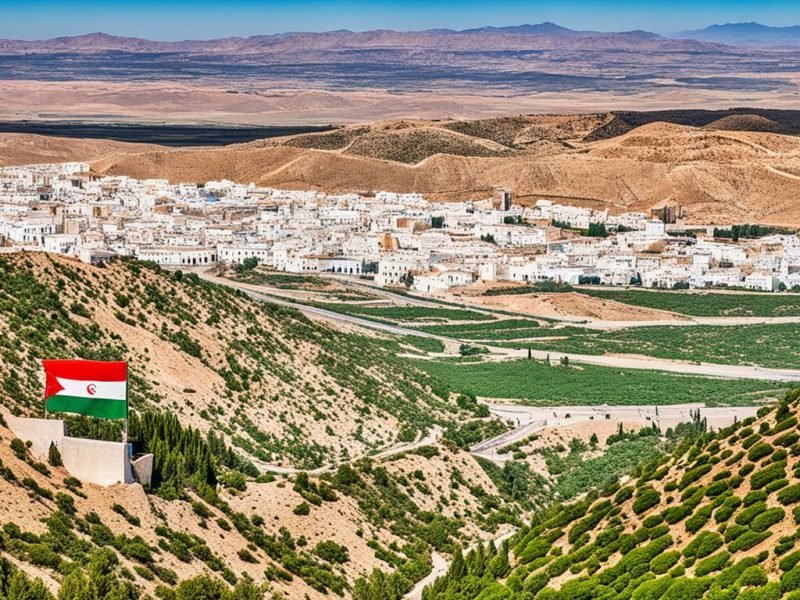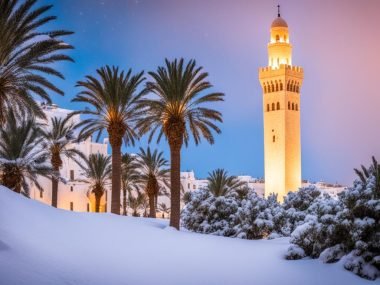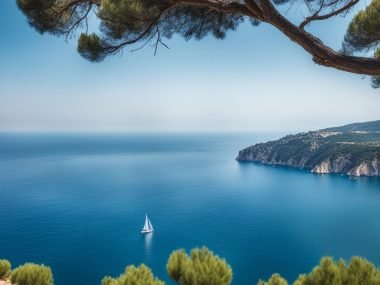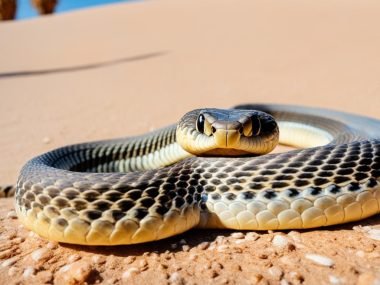Did you know Algeria and Tunisia’s border is 1034 kilometres long? People often ask, “Is Algeria in Tunisia?” The answer is no. Algeria and Tunisia are separate countries in Africa. They are both mainly Muslim and belong to groups like the African Union and the Arab League. This shows they have a lot in common. They both have a history of being ruled by dynasties, being under French control, and working towards good relations after getting independence. The border, made official in 1960, shows how they coexist in the world.
Key Takeaways:
- Algeria and Tunisia are neighbouring but sovereign countries in North Africa.
- The two nations share a 1034-kilometre border, established in 1960.
- Both are predominantly Muslim and members of the African Union and Arab League.
- They share a complex history of dynastic rule and French colonial occupation.
- Post-independence efforts have focused on fostering positive relationships.
Overview of North African Geography
North Africa has several key countries. They make the region’s landscapes rich and diverse. These countries are at the continent’s northern tip. They have unique features that set them apart.
Key Countries in North Africa
North Africa’s geography includes five main countries: Morocco, Algeria, Tunisia, Libya, and Egypt. They form a line along the Mediterranean. They reach into the Sahara Desert.
- Morocco: It has a big coastline on the Atlantic and Mediterranean. Morocco’s land has the Atlas Mountains and Sahara Desert.
- Algeria: Africa’s largest country, Algeria, has plains, desert, and mountains. The Tell Atlas are in it too.
- Tunisia: Tunisia is important because of its long Mediterranean coast. This coast has helped Tunisia a lot over time.
- Libya: Libya is mostly desert. But it also has a lot of oil. This oil is very important for its money and power.
- Egypt: Egypt is known for the Nile River and deserts. It’s a key centre for culture and history in North Africa.
Geographical Diversity
Each North African country has its own kind of geography. This adds to the region’s rich culture and nature. From green areas near the sea to the dry Sahara.
| Country | Geographical Location | Notable Features |
|---|---|---|
| Morocco | Northwest corner of Africa | Atlas Mountains, Sahara Desert, Atlantic Coastline |
| Algeria | North-central Africa | Tell Atlas, Sahara Desert, Largest landmass |
| Tunisia | North tip of Africa | Mediterranean Coastline, Strategic location |
| Libya | East of Algeria | Petroleum reserves, Desert terrain |
| Egypt | Northeast corner of Africa | Nile River, Ancient Civilisations, Sahara Desert |
In conclusion, geography shapes North African countries a lot. Their diverse land makes this region rich in culture, possible earnings, and history.
Understanding the Borders: Algeria and Tunisia
The border between Algeria and Tunisia stretches over 1034 km. It features mountains and desert. This line shows more than places on a map. It tells of culture and politics too.
The Length and Nature of the Border
The border’s nature changes a lot from start to end. From the sea, it moves through Algerian forests and into Tunisia’s deserts. These areas affect how both countries look after their borders.
Historical Border Agreements
Tunisia’s border with Algeria has deep history. Formally set in 1960, its story includes old battles and deals. Once controlled by the Ottomans, the area saw many changes. Now, both nations focus on peace and working together along their border.
The Geographical Location of Algeria
Algeria is key to understanding North Africa. It’s the biggest country in this region. It has many climates and areas.
Located in the Maghreb, it touches Tunisia to the northeast. This spot is very important strategically.

Algeria’s Position in North Africa
Algeria stretches from the north’s Mediterranean coast to the Sahara in the south. Its size and place mean a lot in its links with nearby countries. Here, coastlines meet mountains and deserts.
Significance of Algeria’s Size
Algeria’s vast lands bring different weathers. It’s huge, covering 2,381,741 km2. You find green lands and the big, dry Sahara.
This big area is full of nature’s riches. It also shows Algeria’s long history and mix of cultures. Many civilisations have left their mark here over time.
| Aspect | Details |
|---|---|
| Total Area | 2,381,741 km2 |
| Climate | Semi-arid in the Sahara, Fertile in the North |
| Major Regions | Costal, Desert, Mountains |
| Bordering Countries | Tunisia, Libya, Niger, Mali, Mauritania, Western Sahara, Morocco |
The Geographical Location of Tunisia
Tunisia is at the top of Africa and has great location perks. It’s next to the Mediterranean Sea, making trading easy. This spot shows how important Tunisia’s coastline is for its economy and history.
Tunisia’s Coastal Advantages
Tunisia’s coastline gives it a big edge for business and history. Cities like Tunis and Sfax do well because they can trade easily with Africa and Europe. These trade routes are very important and have helped Tunisian cities for a long time.
Tunisian Cities Near the Algerian Border
Some Tunisian cities like Tabarka and El Kef are very close to Algeria. This closeness shows how the two countries have shared history and influenced each other. These Tunisian cities have strong ties with Algeria. This helps both countries work together and grow.
Historic Relations Between Algeria and Tunisia
Algeria and Tunisia have had significant history, especially during times of conflict and colonisation. Their relationship has gone through many changes, from fights over land to working together after gaining independence. These bonds are complicated but very important.
Pre-Colonisation Conflicts
Long before the French came, this area saw many conflicts. Tunisia and Algeria often fought over land and resources. They also had complex relationships due to the Ottoman period. They would compete for power frequently.
Colonial Influence by France
French colonial rule brought big changes to both Algeria and Tunisia. Their social and economic systems were greatly altered. This set them on paths towards independence. While both faced similar challenges from colonisation, they each took their own way to sovereignty. This helped strengthen their bond after getting independence.
Is Algeria In Tunisia?
People often ask, “Is Algeria in Tunisia?” They get mixed up about these two places. Algeria and Tunisia are both in North Africa. Yet, they are different countries.
Algeria is Africa’s biggest country. It has deserts and varied landscapes. Tunisia is smaller by the sea. It’s known for its beaches.
They share a long border. But, they have their own rules and cultures. They are neighbours, not the same country.
- Algeria’s land is very big and has different weather zones.
- Tunisia’s spot by the sea helps its economy and history a lot.
- Even though they are close, their cultures and politics are unique.
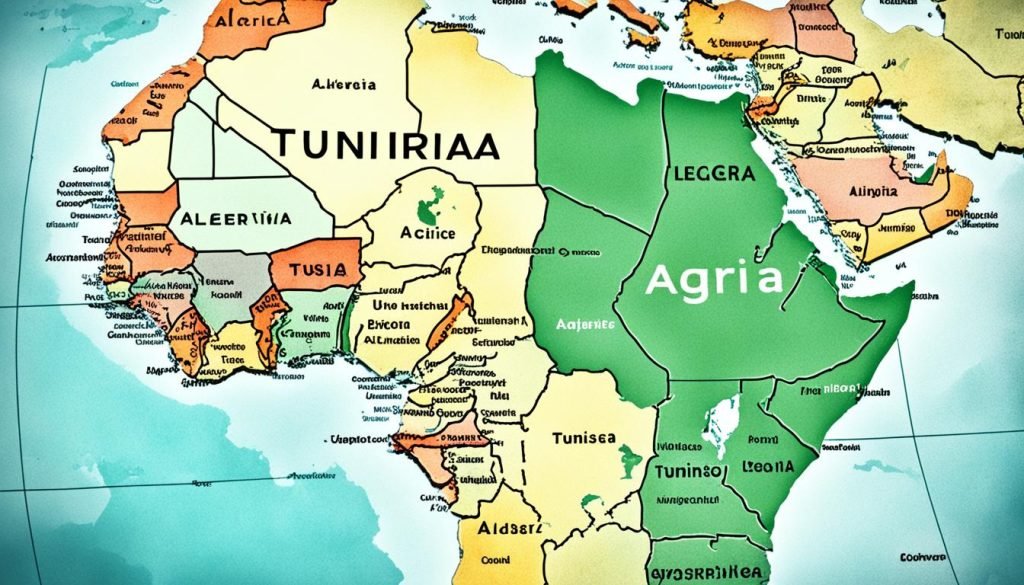
Knowing exactly where Algeria and Tunisia are helps us understand this area better. The question, “Is Algeria in Tunisia?” shows we mix them up. But, they stand alone as nations.
Here’s a quick look at their differences:
| Country | Landmass (km2) | Key Features |
|---|---|---|
| Algeria | 2,381,741 | Diverse lands, big deserts, and a rich history. |
| Tunisia | 163,610 | Great coastal spot, old trade paths, and lively cities. |
Getting geography right stops confusion. It shows Algeria and Tunisia are unique and independent.
Land Borders and Their Implications
It’s key to know about the land borders between Algeria and Tunisia. These borders were once areas of conflict. Now, they help with economic and cultural sharing. keep peace and teamwork going.
The border stretches about 1034 km. It shows the deep ties between the two countries. Long-time disputes shaped these borders. Now, there are deals about safety and lawful travel.
These land borders boost trade. They make the economy of both nations stronger. Formal deals have improved security and regional peace. These deals mean more than just lines on a map. They show how the two countries work on big challenges together.
These borders affect many things. They change how people and goods move. They are important for both the countries’ economies and local folks. Good agreements make these borders work better. This shows how key working together is.
To finish, the borders between Algeria and Tunisia are very important. They show how important agreements are. These borders touch on safety, business, and how people connect. Knowing about these helps us understand more about North Africa’s bigger picture.
Economic and Cultural Connections
Algeria and Tunisia have been working together for a long time. They use their history and geography to build strong trade links. One big project is a pipeline that carries resources from Algeria through Tunisia to Italy. This shows their economic connection and how important they are in trade.
Trade Routes and Economic Cooperation
The trade paths between these countries boost their economies. They work on projects together to improve economic ties in North Africa. The Arab Maghreb Union is one platform they use to help the region grow economically. Both countries are active members.
Shared Cultural Heritage
Algeria and Tunisia also share a rich culture that goes back centuries. This culture comes from their Arab-Muslim traditions. It has made both countries richer in spirit.
Festivals, art, and music link their cultures. They celebrate their history and ongoing connection.
In the end, the work and cultural ties between Algeria and Tunisia show a strong bond. They both want a bright future together.
Political Relationships in Modern Times
After gaining independence, Algeria and Tunisia faced complex political ties. Their different paths to freedom and alliances during the Cold War brought some tension. But, over time, things changed with both cooperation and conflict happening.
Post-Independence Dynamics
After becoming independent, Algeria and Tunisia saw tricky politics. Algeria chose a revolutionary way, while Tunisia went for a diplomatic one. During the Cold War, Algeria leaned towards socialist countries. Tunisia, however, kept a neutral and Western-friendly view. This led to some political troubles. Yet, they both saw the value in working together, especially against terrorism and for regional safety.
Recent Collaborations and Disputes
In the last few years, Algeria and Tunisia have worked hard to get closer politically. They’ve teamed up on big issues like the Arab Spring and needed all-around teamwork. Sometimes, they disagree, like on border safety and managing resources. But overall, they’re aiming for better talks and team projects.
To get the full picture of Algeria and Tunisia’s politics, look at their history and recent teamwork. They’re both working hard for a stable and helpful partnership. They know that their area’s stability and success are linked.

